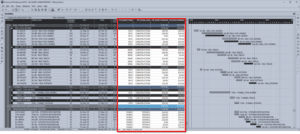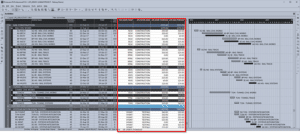Mehdi Takabi
Why do we need to analyze near-critical paths in our project schedule?
Most schedulers and project managers only focus on the critical path. In contrast, some activities in the schedule could become critical due to any unexpected circumstances or delays. These activities have fewer floats and a greater risk of becoming critical. Although adequate attention is paid to critical path activities, it is unwise to focus solely on the critical activities and overlook the near-critical activities. Insufficient attention to near-critical activities may surprise project managers when they become critical during the periodic schedule updates. Therefore, schedulers must be able to identify and analyze near-critical activities.
How to identify and analyze the near-critical paths?
Near-criticality is based on the CPM (Critical Path Method) calculations that evaluate how close any activity is to becoming a critical activity. Near-criticality applies to both activities and a network path.
There are several methods to identify near-critical activities. Some of these methods are solely based on the total float values to determine the activities’ criticality. For instance, some schedulers suggest a range of total float values between 1 to 5 days for determining near-critical activities.
Another method to identify near-critical activities is the 5% rule method. In this method, all activities in which their total float is less than 5% of the remaining project duration are considered near-critical.
These methods are pretty easy and straightforward but are too subjective and highly dependent on the total float values. As many schedulers know, various schedule parameters play an important role in calculating the total float, such as constraints, activity calendars, total float calculation methods, out-of-sequence progress, lag calendars, etc.
Therefore schedulers are encouraged to undertake a more detailed analysis of near-critical activities using the longest path theory concept. The longest path in the schedule is defined as the longest sequence of activities, establishing the minimum overall duration of the project. The closeness of any other network path to the longest path is the measure of the near-critical path. There are two algorithms in the Longest Path theory for determining near-critical paths:
- Longest path values
- Multiple float paths
Fortunately, the second algorithm, multiple float paths, is supported by Primavera P6.
Multiple float path calculation in Primavera P6 is accessible through the ‘Advanced’ tab of the ‘Schedule Options’.
Using multiple float path analysis, you can identify and organize the logic paths leading to selected End activity in a schedule.
To view the result of multiple float paths calculation, you need to display the activities by selecting ‘Float Path’ from the ‘Group and Sort’ dialogue box.
According to Oracle documentation, the most critical path (Float Path 1) will be identical to the longest path if you choose the ‘Free Float’ option from the above ‘Schedule Options’ dialogue.
Summary
Near-critical activities can be important as critical activities in a schedule. Although there are methods that are solely based on total float values for identifying near-critical activities, it is recommended to identify and analyze near-critical paths based on the multiple float paths algorithm that Primavera P6 offers. There are several drawbacks to using total float value as the only indicator of near-critical activities. Total float calculation is highly impacted by some schedule characteristics like constraints, multiple calendars, out-of-sequence, etc. and selecting criteria and ranges to filter the activities is entirely subjective. In contrast, calculation in the multiple float paths algorithm is based on the longest path theory, an objective method, without worrying about the drawbacks mentioned before regarding the total float methods.






